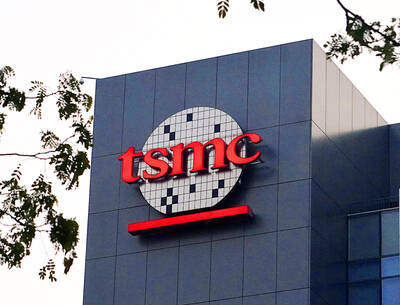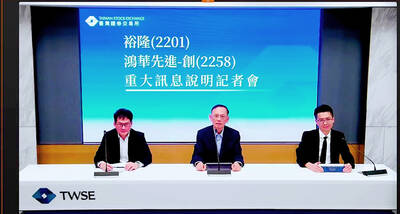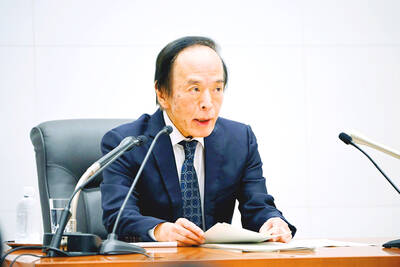Largan Precision Co (大立光), the nation’s leading camera lens manufacturer, yesterday gave a bleak outlook for this quarter due to the uncertainty engendered by the COVID-19 pandemic, after posting its strongest-ever first-quarter net profit, which surged 32.97 percent year-on-year to NT$6.72 billion (US$222.87 million).
This figure translated into earnings per share of NT$50.1, up from NT$37.68 a year earlier.
Revenue last quarter increased 34.52 percent to NT$13.21 billion.
Gross margin climbed to 69.8 percent from 64.24 percent, thanks to an improved product mix, as well as higher average selling prices (ASP), the company said.
A shipment breakdown showed that 10 to 20-megapixel lenses accounted for 40 to 50 percent of the total, 20-megapixel lenses and above made up 20 to 30 percent, and 8-megapixel lenses constituted about 10 to 20 percent.
Despite a strong first quarter, the company said that uncertainty created by the pandemic would take a toll on its revenue this quarter.
“We expect April [revenue] to disappoint [compared with March sales], with May [sales] even worse,” Largan CEO Adam Lin (林恩平) told investors at an earnings conference, adding that the firm has no order visibility for June.
This would lead to a drop in capacity utilization rates, Lin said, but added that the projections are based on current client orders, which could change rapidly depending on market conditions.
Asked whether Largan could meet rush orders when the pandemic subsides, Lin said it could ramp up production within one to two weeks time as long as the necessary modules are already available.
“Our employees are still working full time,” he added.
As to market speculation about potential delays in customers’ product launches, Lin declined to comment, but said that some of Largan’s projects would indeed be affected by laboratory closures.
Lin said Largan might shift more production to low to mid-range lenses, but said this might undermine margins given a lower ASP.
Largan is developing free-form lenses, which reduce spherical aberrations that occur in conventional camera lenses, Lin said, adding that it would be available by the end of the year.

Taiwan’s long-term economic competitiveness will hinge not only on national champions like Taiwan Semiconductor Manufacturing Co. (TSMC, 台積電) but also on the widespread adoption of artificial intelligence (AI) and other emerging technologies, a US-based scholar has said. At a lecture in Taipei on Tuesday, Jeffrey Ding, assistant professor of political science at the George Washington University and author of "Technology and the Rise of Great Powers," argued that historical experience shows that general-purpose technologies (GPTs) — such as electricity, computers and now AI — shape long-term economic advantages through their diffusion across the broader economy. "What really matters is not who pioneers

In a high-security Shenzhen laboratory, Chinese scientists have built what Washington has spent years trying to prevent: a prototype of a machine capable of producing the cutting-edge semiconductor chips that power artificial intelligence (AI), smartphones and weapons central to Western military dominance, Reuters has learned. Completed early this year and undergoing testing, the prototype fills nearly an entire factory floor. It was built by a team of former engineers from Dutch semiconductor giant ASML who reverse-engineered the company’s extreme ultraviolet lithography (EUV) machines, according to two people with knowledge of the project. EUV machines sit at the heart of a technological Cold

TAIWAN VALUE CHAIN: Foxtron is to fully own Luxgen following the transaction and it plans to launch a new electric model, the Foxtron Bria, in Taiwan next year Yulon Motor Co (裕隆汽車) yesterday said that its board of directors approved the disposal of its electric vehicle (EV) unit, Luxgen Motor Co (納智捷汽車), to Foxtron Vehicle Technologies Co (鴻華先進) for NT$787.6 million (US$24.98 million). Foxtron, a half-half joint venture between Yulon affiliate Hua-Chuang Automobile Information Technical Center Co (華創車電) and Hon Hai Precision Industry Co (鴻海精密), expects to wrap up the deal in the first quarter of next year. Foxtron would fully own Luxgen following the transaction, including five car distributing companies, outlets and all employees. The deal is subject to the approval of the Fair Trade Commission, Foxtron said. “Foxtron will be

INFLATION CONSIDERATION: The BOJ governor said that it would ‘keep making appropriate decisions’ and would adjust depending on the economy and prices The Bank of Japan (BOJ) yesterday raised its benchmark interest rate to the highest in 30 years and said more increases are in the pipeline if conditions allow, in a sign of growing conviction that it can attain the stable inflation target it has pursued for more than a decade. Bank of Japan Governor Kazuo Ueda’s policy board increased the rate by 0.2 percentage points to 0.75 percent, in a unanimous decision, the bank said in a statement. The central bank cited the rising likelihood of its economic outlook being realized. The rate change was expected by all 50 economists surveyed by Bloomberg. The